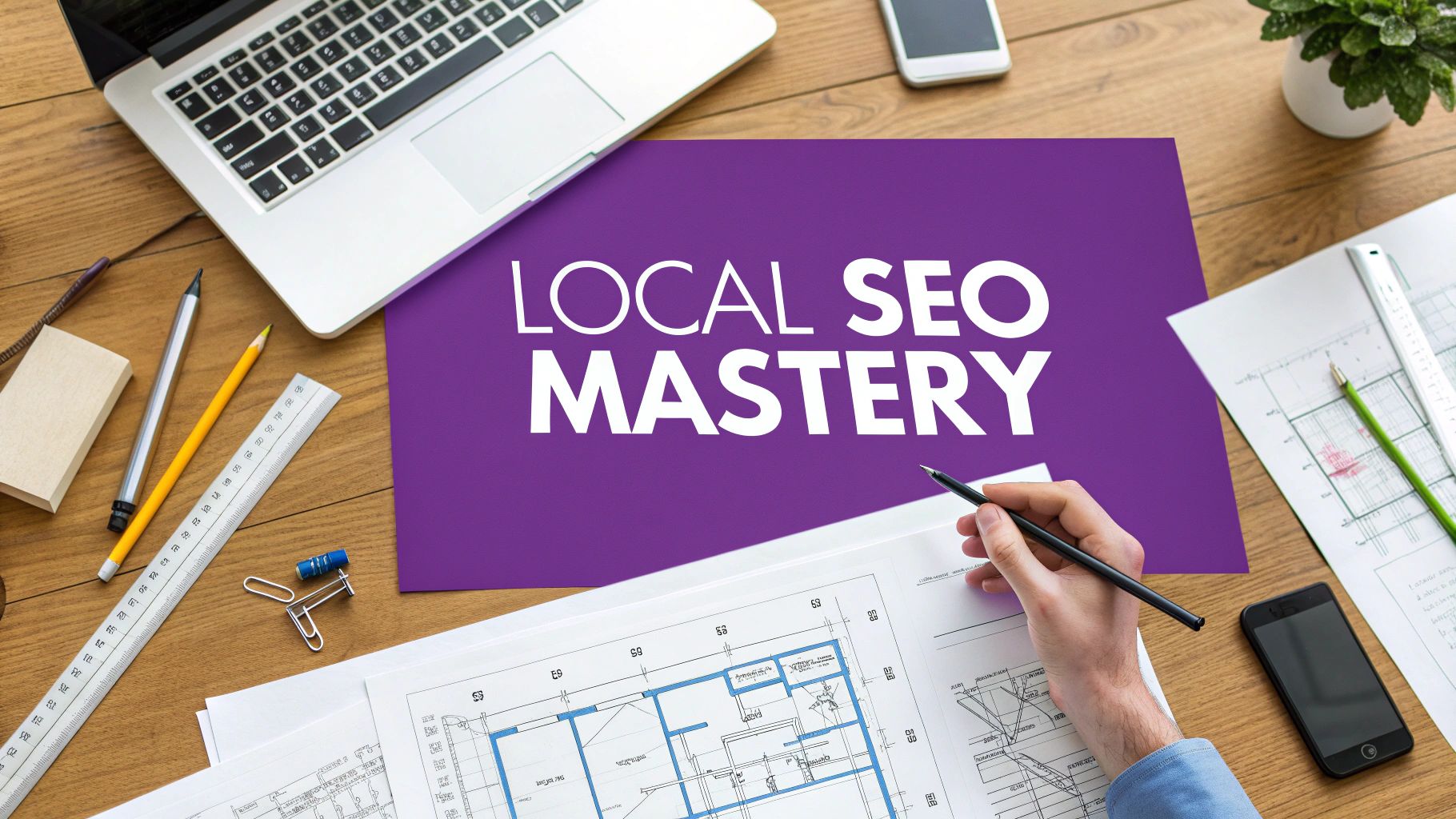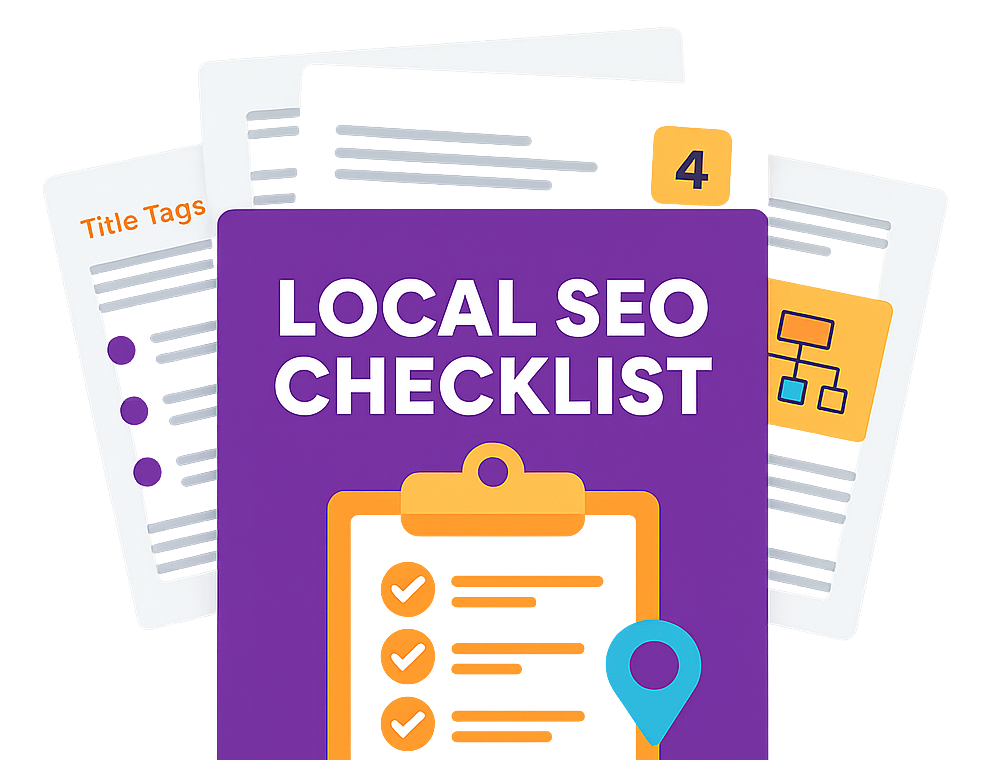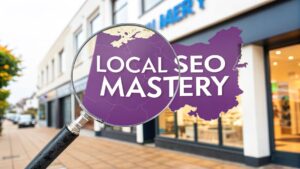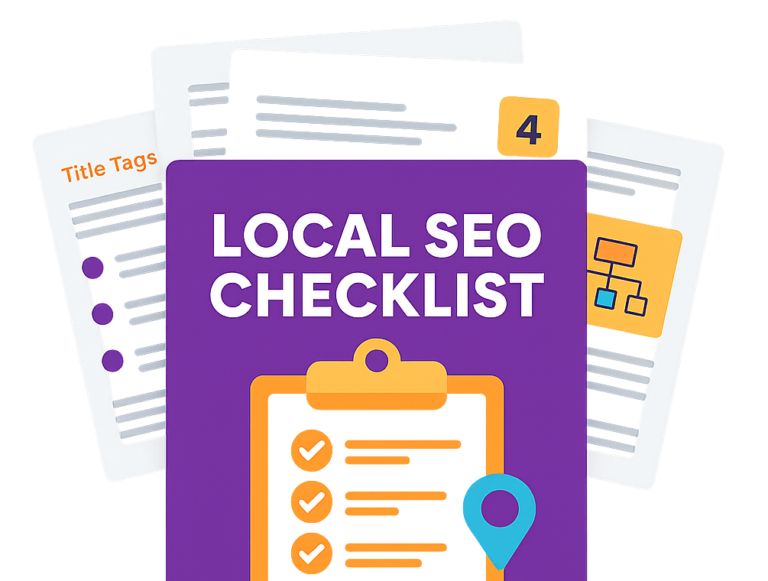Local SEO is all about making sure your architectural firm shows up when potential clients in your area search online. Think of it like this: when someone types 'architects in Manchester' or 'residential architect near me' into Google, you want your practice to be front and centre. It's the most direct way to connect with high-value prospects right in your backyard.
Why Your Firm Needs Local SEO to Compete
Relying on word-of-mouth referrals alone just doesn't cut it anymore. That might have worked a decade ago, but today, the journey to commissioning a new project almost always starts with a search engine. A strong local online presence puts your firm on the map at the exact moment a potential client is looking for your skills.
This isn't just about visibility; it’s about building trust from the very first click. When you consistently appear in local searches, you establish your practice as the go-to authority in your area long before you ever speak to a client. It's about being seen by the right people, in the right place, at precisely the right time.
The Shift to Digital Discovery
The architecture industry used to run on handshakes and networking events. Now, it runs on digital discovery. Potential clients are more informed and proactive than ever. In fact, recent research shows that over 70% of prospects check out architectural services online before making contact, and they typically review three to five websites before even thinking about picking up the phone.
This paints a very clear picture: your firm's local search ranking is directly tied to its ability to win new projects. You can learn more about these client behaviour trends and how to adapt your strategy accordingly.
A strong local SEO presence isn't a marketing 'nice-to-have' anymore; it's a fundamental business requirement. Failing to show up in local search results is the modern equivalent of having an unlisted phone number.
Understanding Modern Client Behaviour
Just how much of an impact can local visibility have? The numbers speak for themselves. Here’s a quick look at the statistics that show why optimising for local search is so critical for architectural firms today.
| How Local SEO Transforms Architectural Firms | |
|---|---|
| Statistic | Impact on Your Practice |
| 70%+ of clients research online before contacting a firm. | Your website is your new front door. A strong online presence is essential for making a great first impression. |
| 60% of local queries are 'near me' searches. | Clients are actively looking for local expertise. Appearing in these results connects you with immediate opportunities. |
| The Google 'Local Pack' has a 30% click-through rate. | Securing a spot in the top three map results can drive a significant amount of high-intent traffic directly to you. |
These figures highlight a clear trend: your next big project is likely to come from a local search, and it will probably be from someone on their mobile phone.

This data confirms that the game has changed. The overwhelming majority of local searches happen on mobile devices, which makes two things non-negotiable: a mobile-friendly website and a top position in Google's local pack results. Getting these right is essential if you want to capture new business in your area.
Optimising Your Google Business Profile
Think of your Google Business Profile (GBP) as your firm’s digital front door. It’s often the very first impression a potential local client will have of your practice, and it’s arguably the cornerstone of local SEO for architects.
Claiming your profile is just the starting line. The real wins come from meticulous, ongoing optimisation. It’s the most powerful free advertising you’ll ever get, acting as a mini-website that shows up right in Google's search results and on Maps. A fully tuned profile doesn't just list your address; it’s a magnet for the right kind of enquiries, showcasing your expertise, projects, and client feedback.
Choosing Your Core Categories
The categories you choose are critical. "Architect" is the obvious primary choice, but don't stop there. Google lets you add secondary categories, and this is where you can get smart and capture more specific searches. This detail helps Google understand the nuances of your services, putting you in front of a much more relevant audience.
Consider adding categories like:
- Architectural Designer: A great fit if you offer distinct design services.
- Urban Planner: Perfect for firms involved in larger-scale community or development projects.
- Interior Designer: Essential if this is a key part of your service offering.
This simple tweak helps you show up for searches that go beyond the generic "architect," connecting you with clients who already know what they're looking for.
Here’s a look at how a standard Google Business Profile appears in search results.

As you can see, essential details like the map, address, hours, and photos are displayed front and centre, making it incredibly easy for local clients to find and get in touch.
Crafting a Compelling Business Description
Your business description is your chance to weave in local keywords and tell your firm's story. Don't just spit out a list of services. Instead, explain what makes your practice the go-to choice in your area.
Mention specific towns or neighbourhoods you serve, or architectural styles you specialise in. For example, something like, "A RIBA-chartered practice specialising in sustainable home extensions and Passivhaus design in the Cambridge area," is far more powerful than "We offer architectural services."
Your GBP is a powerful tool for converting searchers into leads. A well-optimised profile can directly influence whether a local client picks up the phone to call your firm or a competitor.
The data backs this up. In the UK, a staggering 76% of people who run a "near me" search for a local service—and that includes architects—will visit a business within 24 hours. Firms with properly optimised profiles reap the rewards, seeing up to 426% more discovery searches than those who neglect it.
Using Visuals and Posts to Your Advantage
High-resolution, geotagged images of your work are non-negotiable. This is your visual portfolio. Showcase your best projects—completed, in-progress, the lot. Don't forget to include photos of your team and office, as this builds trust and gives potential clients a real sense of who you are.
Beyond photos, you need to use GBP Posts. These are like mini blog updates that appear directly on your profile. Use them to share firm news, highlight a recently completed project, or even announce an open day. They keep your listing active and engaging, which Google loves.
Proactively answering questions in the Q&A section is another great tactic. It establishes your authority and helps prospects get the information they need, fast. For a much deeper dive, check out our complete guide on Google Business Profile optimisation.
Finding Keywords That Attract Local Projects
Good local SEO for architects is all about speaking your client's language. To land the high-value local projects you actually want, you need to get inside their heads and figure out the exact phrases they’re typing into Google when they’re ready to hire. This means going way beyond generic terms like "architect" and digging into what a real prospect is thinking.
The goal isn't just about search volume; it's about relevance and intent. Most architecture-related keywords have a lower search volume than other industries, and that's completely fine. You only need a handful of great clients each year to transform your practice, and targeting super-specific, low-volume keywords is often the quickest way to find them.
Think Like a Client
First things first, put yourself in your ideal client's shoes. What problem are they actually trying to solve? Are they dreaming of a kitchen extension, stressing about planning permission for a new build, or searching for a specialist to handle a tricky listed building renovation?
This brainstorm should give you a solid list of your core services. From there, it’s just a matter of adding location-based modifiers to make them powerful local keywords.
- Service + Location: "residential architect Bristol," "loft conversion specialist Hackney"
- Problem + Location: "planning permission help Surrey," "listed building consent Bath"
- Building Type + Location: "modern house architect Cheshire," "commercial architect Manchester"
These longer, more specific phrases are called long-tail keywords. While fewer people search for them each month, the person who does has a crystal-clear idea of what they need. That makes them an incredibly qualified lead for your firm.
Uncovering Hyperlocal Opportunities
Don't just stop at the city or county level. Getting hyperlocal—by targeting specific towns, postcodes, or even well-known neighbourhoods—can be a game-changer. A potential client living in Richmond is far more likely to search for "house extension architect in Richmond" than a broader term. It's just human nature.
The intent behind a search is everything. Someone searching for "architect" could be a student doing research. But someone searching for "RIBA architect for a barn conversion in the Cotswolds" is almost certainly a potential client with a real project and a budget. Your entire keyword strategy should be about attracting that second person.
When you create service pages and case studies that specifically mention these smaller areas, you're sending a strong signal to Google that you are the local expert. This is how you start to dominate the search results for the communities you really want to work in, bringing in the most relevant local enquiries. The trick is to weave these phrases naturally into your project descriptions, service pages, and blog posts so it all feels authentic.
Tuning Your Website for Local Search Signals
A powerful Google Business Profile is a huge piece of the puzzle, but your website is the other half of the local SEO equation for architects. To really own the local search results, your site needs to send crystal-clear, consistent signals to Google that confirm exactly where you are and what you do. This whole process of on-page optimisation is what helps search engines connect your firm to local clients when they're searching.
Without these signals, you're practically invisible to potential clients in your own backyard. Luckily, making these tweaks is pretty straightforward and can deliver some serious results. It's all about making it dead simple for both people and search engines to see you as a local authority.

Reinforce Your Location on Every Page
One of the most critical moves you can make for local SEO is ensuring your Name, Address, and Phone number (NAP) are consistent right across your website. The best place for this? Stick it in your website's footer, so it shows up on every single page.
This consistency acts as a constant trust signal for Google. It's like you're repeatedly telling the search engine, "Yep, the details on my website match my Google Business Profile and all those other online directories." It’s a small detail that has a massive impact on your local credibility.
A recent study really drove this point home. It found that architectural firms in the top SEO quartile get 4.5 times more monthly website traffic than those at the bottom. But here’s the kicker: the same study showed that only 43% of firms had both their phone number and address on their website. That's vital info for getting ranked in Google’s local map packs. You can dig into the full findings of this 2025 architecture SEO study on WebwispUK.
Optimise Your Contact and Location Pages
Your contact page has to be more than just a simple form. Think of it as your prime real estate for shouting about your location.
- Embed a Google Map: An interactive map showing your office is a powerful visual cue. It connects directly to your GBP listing and reinforces your physical presence.
- List Full NAP Details: Spell out your full address and phone number, making sure it’s an exact match to what’s on your GBP.
- Include Opening Hours: Add your business hours to maintain complete consistency.
If your practice has more than one office—say, one in London and another in Manchester—each one deserves its own dedicated location page. Each of these pages should have its own unique NAP, a map, and content specific to that office and the projects it handles in the area.
A well-optimised location page tells a potential client, "We are right here, and we understand your local area." It transforms your website from a generic brochure into a targeted local resource.
To make sure your pages are technically sound and sending all the right signals, it’s smart to do a regular check-up. You can use our technical SEO audit checklist to make sure you don't miss anything. This whole process helps you build pages that not only appeal to clients but also perform brilliantly in local search.
Building Authority with Local Citations and Links
Your firm’s online reputation isn’t just about what’s on your own website. To really convince Google that your practice is a local authority, you need strong endorsements from other reputable places online. These endorsements come in two main flavours: local citations and backlinks.
Think of a local citation as an online mention of your firm's name, address, and phone number (we call this NAP). Every time your NAP details show up consistently on a trusted website, it's like a vote of confidence, verifying that your business is legitimate and located where you say it is.
A backlink, on the other hand, is a clickable link from another website straight to yours. These are gold. Search engines see them as direct referrals, a clear signal that your content is valuable enough for someone else to point their own audience toward it.
Securing Essential Local Citations
First things first, you need to get your architectural practice listed correctly on the UK’s most important online directories. Consistency is everything here. Even a small variation in your firm's name, address, or phone number across different platforms can confuse search engines and water down your local authority.
The goal is to target a mix of general business directories and those specific to the architecture and construction industry. Getting this foundational work right ensures that wherever a potential client is looking, they find the same, accurate information about your practice.
It's a good idea to build a curated list of essential online directories for UK architects to ensure your business information is listed accurately.
Essential UK Citation Sources for Architects
| Directory Type | Examples |
|---|---|
| General Directories | Yell, Thomson Local, 192.com, Scoot |
| Industry-Specific | RIBA Find an Architect, Houzz, Local Surveyors Direct |
| Review Platforms | Google Business Profile, Trustpilot, Reviews.co.uk |
Building out these profiles one by one is a bit of a grind, but it's an absolutely essential task. If you're short on time, you could look into professional services that handle local directory submissions to guarantee accuracy and free you up to focus on design work.
Earning High-Quality Local Backlinks
While citations build a foundation of trust, high-quality backlinks are what will really put the accelerator down on your local SEO. Earning these links isn't passive; it requires a more proactive approach because they are genuine editorial endorsements from other websites. They tell Google you’re a recognised expert in your field and a key player in the local business community.
You don't need to aim for national press right away. Focus your efforts on realistic, achievable opportunities within your local ecosystem.
- Local News and Media: Has your firm designed a notable local building or won an award? That’s a story. Reach out to local newspapers or community blogs with a press release.
- Construction & Design Blogs: Offer to write a guest article for a UK-based construction, property, or interior design blog. Share your expertise on a specific topic—sustainable materials, navigating planning permission, anything you know inside and out.
- Community Sponsorships: Sponsoring a local charity event, a kids' sports team, or a community festival is not only good for the soul but often results in a backlink from the organisation’s website.
Each quality backlink from a relevant local source is like a digital recommendation. It’s another website pointing to you and telling Google, "This architectural firm is a trusted, important part of our local community." This is how you build an authoritative online presence that’s difficult for competitors to replicate.
Using Client Reviews to Build Trust
When it comes to local SEO for architects, don’t ever underestimate the power of client reviews. They're so much more than just a few nice words to stick on your website. Think of them as a currency of trust and a direct signal to Google that you’re a reputable local firm.
A steady stream of genuine, positive feedback is easily one of your most valuable marketing assets.

This feedback is crucial social proof for potential clients doing their homework. Seeing recent, glowing reviews can be the final nudge someone needs to pick up the phone and book that initial consultation. It directly impacts how visible you are in local map results, too.
Encouraging Client Feedback Professionally
I get it, asking for reviews can feel a bit awkward. But it doesn't have to be complicated. The perfect time to ask is right after a project wraps up, when your client is thrilled with the final result. A simple, polite email is often all it takes.
You could try something like, "We've really enjoyed working with you on your new home. If you have a moment, would you be willing to share your experience on our Google Business Profile? Your feedback really helps others who are looking for an architect."
A proactive approach here is non-negotiable. Don’t just sit back and hope for reviews to roll in. By building a simple, professional request into your project completion process, you ensure a consistent flow of fresh, relevant testimonials.
This one simple step will build a library of social proof that validates your expertise and draws in future clients.
Responding to Every Single Review
Getting reviews is only half the battle; responding to them is just as important. It shows you’re engaged, professional, and that you actually value what your clients have to say—whether it's good or bad. Always make a point to thank clients for their positive comments and mention any specific points they brought up.
Now, for the dreaded negative review, your approach is even more critical.
- Respond quickly and keep it professional: Whatever you do, don't get defensive. Acknowledge their experience and reiterate your commitment to client satisfaction.
- Take it offline: Offer to discuss the issue further over the phone or via email. This shows you're taking their concerns seriously without airing dirty laundry in public.
- Learn from it: Use constructive criticism to genuinely improve your processes.
A thoughtful response strategy is a cornerstone of successful online reputation management for SEO, demonstrating your professionalism to every single person who lands on your profile.
Got Questions About Local SEO? Let's Clear a Few Things Up
Most architects I speak with know they should be doing something about local SEO, but a few questions always seem to pop up before they're ready to dive in. It’s completely understandable. You want to know what you’re getting into, so let's tackle the big ones head-on.
How Long Does This SEO Thing Actually Take to Work?
Look, SEO isn't an overnight fix. It's more like laying the foundations for a long-term project. While you might spot some small positive changes within a few weeks, you should realistically expect to see a real impact—like more local enquiries and better rankings—in about three to six months.
That timeframe gives us enough room to do the job properly: sort out the on-page optimisations, create some genuinely useful content, and start building up your firm's authority online. The key here is consistency. The small efforts you make today compound over time, delivering results long after you've done the work.
Is a Blog Really Worth the Effort for My Firm?
Absolutely, and here's why. A blog is your secret weapon for targeting those super-specific, long-tail keywords that serious clients are searching for. Think about phrases like "planning permission tips in Cheshire" or "what are the real costs for a loft conversion in Hackney?"
Creating content around these topics does two brilliant things. First, it pulls in highly qualified local traffic—people who are actively looking for the exact services you offer. Second, it positions your firm as the go-to expert in your area. Every post is a signal to Google that your site is active, relevant, and a valuable resource for its users.
Think of your blog as an ongoing conversation with potential clients. Each post answers a question they might have, building trust and showcasing your expertise long before they even think about picking up the phone.
At Bare Digital, we create local SEO strategies that are built specifically for architectural firms like yours. We cut through the jargon and deliver a clear plan with results you can actually see. Get your free SEO Health Check today!








